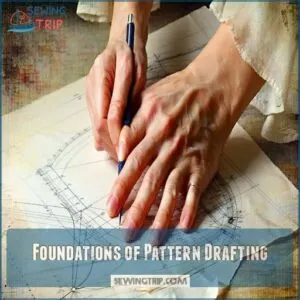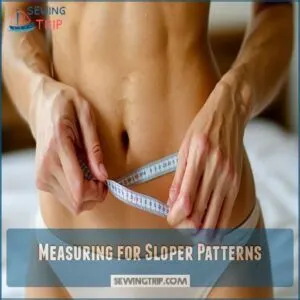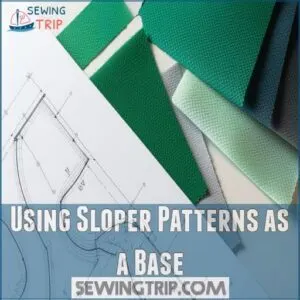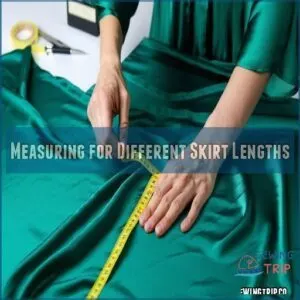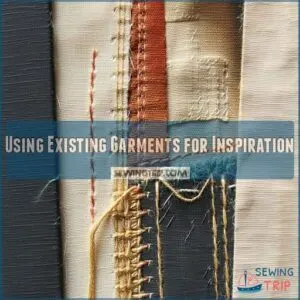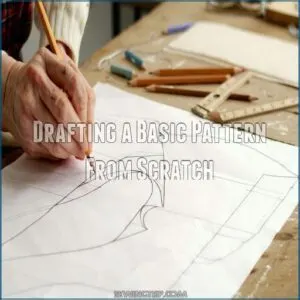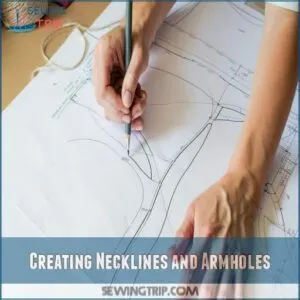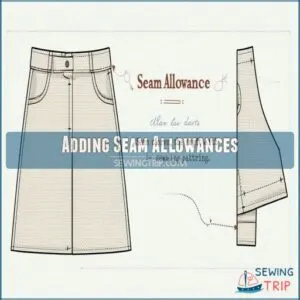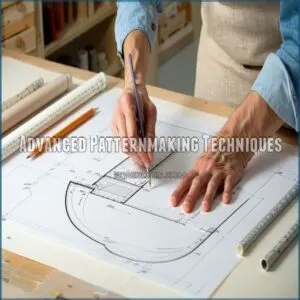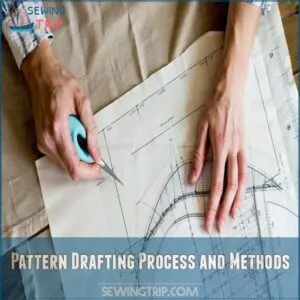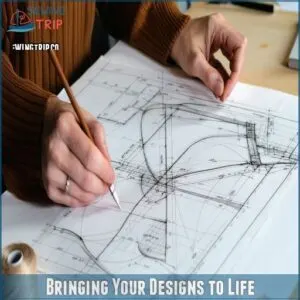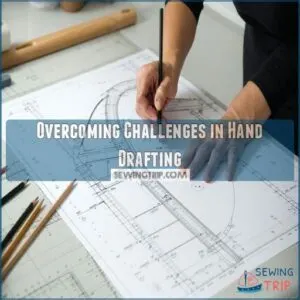This site is supported by our readers. We may earn a commission, at no cost to you, if you purchase through links.
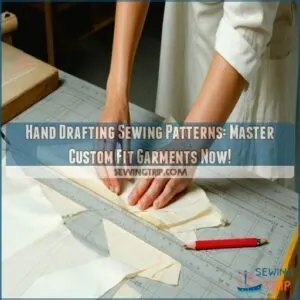
You’ll start by taking precise body measurements and creating a sloper pattern, which acts like a personal blueprint for perfectly fitted garments.
Grab your rulers, pattern paper, and measuring tape to map out your unique silhouette. You’ll learn to manipulate basic patterns, add seam allowances, and create smooth curves for necklines and armholes.
With practice, you’ll transform flat fabric into custom-fit masterpieces.
Test garments become your best friends, helping you refine each design until it’s absolutely perfect.
Ready to discover your inner fashion designer?
Table Of Contents
- Key Takeaways
- Foundations of Pattern Drafting
- Creating Sloper Patterns
- Basic Pattern Drafting Techniques
- Advanced Patternmaking Techniques
- Essential Tools and Materials
- Pattern Drafting Process and Methods
- Bringing Your Designs to Life
- Benefits of Hand Drafting Sewing Patterns
- Overcoming Challenges in Hand Drafting
- Frequently Asked Questions (FAQs)
- Conclusion
Key Takeaways
- You’ll transform your sewing skills by creating a personalized sloper pattern, which serves as your unique body blueprint for perfectly fitted garments.
- Mastering precise body measurements and understanding pattern ease are crucial for drafting custom-fit clothing that celebrates your individual silhouette.
- You’ll need essential tools like pattern paper, flexible rulers, and tracing wheels to turn your creative vision into wearable art through hand-drafting techniques.
- By practicing pattern drafting, you’ll save money, reduce fabric waste, and gain the creative freedom to design garments that fit your body like a glove.
Foundations of Pattern Drafting
Discover the magic of creating perfectly fitted garments that hug your body like a custom-tailored dream.
Pattern drafting isn’t just a skill—it’s your ticket to transforming fabric into wearable art that celebrates your unique shape.
Pattern drafting is your ticket to wearable art.
Importance of Sloper Patterns
Sloper patterns are your secret weapon in hand drafting sewing patterns. They’re the blueprint that transforms your creative vision into perfectly fitted garments.
Like a custom roadmap for your designs, slopers capture your unique body shape, allowing every piece you create to fit like a glove.
Master these foundational patterns, and you’ll discover endless possibilities in your sewing journey. Master these foundational patterns.
Accurate Body Measurements
Getting your hand drafting sewing pattern right starts with measuring like a pro.
Grab your flexible tape measure and stand tall – posture matters!
Measure twice, record carefully, and don’t pull the tape too tight or too loose.
Multiple measurements from different angles guarantee your sloper draft captures every curve and angle of your unique body shape. This ensures an accurate sewing pattern.
Understanding Seam Allowances
Every stitch tells a story, and seam allowances are the unsung heroes of hand drafting patterns.
- Determine standard width (typically 5/8 inch)
- Consider garment type and fabric weight
- Account for stress points and movement
- Check functional versus decorative seams
- Practice consistent measuring techniques
Precision matters more than perfection in your sewing journey.
Pattern Ease and Basic Tools
Beyond seam allowances, your pattern drafting journey hinges on understanding pattern ease and selecting the right tools.
Understanding pattern ease guidelines can greatly impact the fit of your garments.
Your creative canvas depends on smart choices that transform measurements into wearable art.
| Tool | Purpose | Skill Level | Cost |
|---|---|---|---|
| Pattern Paper | Marking Designs | Beginner | Low |
| Flexible Ruler | Precise Measurements | Intermediate | Medium |
| Tracing Wheel | Transferring Lines | Advanced | Low |
| French Curve | Smooth Contours | Expert | High |
Grab your tools, embrace the learning curve, and watch your hand-drafted patterns come alive!
Creating Sloper Patterns
Your sloper pattern is the secret blueprint for creating perfectly fitted garments.
These garments hug your curves just right.
By taking precise body measurements and using this custom base pattern, you’ll transform your sewing skills.
You’ll transform from basic to brilliant, crafting clothes that look like they were made exclusively for you.
Measuring for Sloper Patterns
When you kick off your sloper pattern journey, precision is your secret weapon.
Gather your measurement tools and prepare to map out your unique body blueprint.
Key steps include:
- Stand tall with relaxed shoulders
- Use a flexible tape measure
- Wear form-fitting undergarments
Accurate body measurements are the foundation of hand-crafted patterns that’ll transform your sewing game.
Using Sloper Patterns as a Base
After nailing your precise measurements, your sloper pattern becomes your secret weapon in sewing. Think of it as a custom blueprint that maps out your unique body shape.
Here’s how slopers transform from basic templates to versatile design launchpads:
| Sloper Type | Purpose | Design Potential |
|---|---|---|
| Bodice | Base fit | Tops, dresses |
| Skirt | Waist-hip proportion | A-line, pencil skirts |
| Sleeve | Arm movement | Fitted, loose styles |
| Pants | Lower body contour | Trousers, shorts |
| Jacket | Upper body structure | Blazers, coats |
Mastering sloper adjustments opens a world of pattern variations waiting to be freed.
Measuring for Different Skirt Lengths
Strategically measuring skirt lengths lets you rock versatile pattern pieces that flatter your unique body proportions.
Grab your tape measure and start by marking your waist, then decide between mini, midi, or maxi styles that showcase your personal flair.
Precise hem variations transform basic hand drafting into a customized sewing pattern adventure that celebrates your individual silhouette.
Using the right pattern drafting tools, such as French curves and hip curves, will also help create smooth curves and shapes for your skirt.
Using Existing Garments for Inspiration
Got a killer wardrobe piece that fits like a dream?
Time to turn that favorite garment into your personal pattern blueprint!
Grab those well-loved pieces and start deconstructing. By tracing the seams and lines of clothes that already hug your body perfectly, you’ll discover the secrets to hand drafting sewing patterns that are uniquely yours.
Repurposing old clothes just got exciting!
Basic Pattern Drafting Techniques
Ready to transform your sewing skills by mastering basic pattern drafting techniques?
You’ll learn how to take precise body measurements.
Draft a personalized pattern from scratch.
And create perfectly fitted garments that showcase your unique style.
Taking Essential Body Measurements
Every precise stitch begins with razor-sharp body measurements.
Grab your flexible tape measure and stand tall – your posture matters more than you think.
Capture bust, waist, hips, and height with laser-like accuracy. Record each number carefully, keeping shoulders relaxed.
Pro tip: Measure twice, draft once, and watch your sloper drafts transform from good to absolutely stellar.
Drafting a Basic Pattern From Scratch
After nailing your body measurements, you’re ready to turn those numbers into a basic bodice block.
Start by drawing horizontal lines for key points: shoulders, bust, waist, and hips.
Mark precise points and connect them with smooth, curved lines that mirror your unique shape.
Your first pattern is a canvas waiting to capture your personal silhouette – embrace the creative journey of drafting clothes patterns.
Creating Necklines and Armholes
Explore the art of creating necklines and armholes, where your pattern’s personality truly takes shape.
Trace smooth, precise curves that hug your body’s natural lines.
paying close attention to depth and the finished garment measurements.
Whether you’re drafting a boat neck or a classic round armhole, each line you draw transforms your sewing pattern from basic to brilliant.
Adding Seam Allowances
Nailing necklines and armholes sets the stage for your pattern’s success.
Seam allowances are your secret weapon in crafting a professional finish.
Think of seam allowances as the buffer zone between raw fabric edges and your final stitch line.
Understanding a seam allowance guide can help you navigate this buffer zone.
Most patterns use a standard 5/8-inch allowance, giving you wiggle room for precise sewing and potential adjustments.
Advanced Patternmaking Techniques
You’re ready to elevate your pattern drafting skills from basic to brilliant with advanced techniques that transform your sewing projects.
These powerful methods will help you master pattern grading, seam shifting, and creating test garments.
guarantee a perfect, professional-looking fit every time.
Pattern Grading and Seam Shifting
Mastering pattern grading and seam shifting opens up a world of custom-fit possibilities. Ready to level up your sewing skills? These advanced techniques transform basic patterns into perfectly fitted masterpieces.
With a solid understanding of measuring body shape, you can confidently tackle pattern manipulation.
- Feel the rush of creating garments that fit like a glove
- Harness the power of professional-grade pattern manipulation
- Conquer size variations with confidence
- Embrace your inner design genius
- Transform flat patterns into stunning, personalized pieces
Grading isn’t just about making magic happen.
Cutting and Spreading Techniques
Pattern cutting is your secret weapon for reshaping fabric landscapes.
Slice strategically along pattern pieces, spreading or closing sections to manipulate design lines with laser precision.
Efficient cutting techniques transform hand-drawn patterns, respecting fabric grainlines while minimizing waste.
Learn to spread pattern pieces intentionally, giving your garment design room to breathe and take shape exactly as you envision.
Creating Test Garments and Evaluating Fit
Transform your test garments into a roadmap for sewing success. Your mock-up musings reveal the secret to perfect fit and style.
Consider these essential steps for evaluating your garment:
- Assess fabric choice impact on overall drape and movement
- Perform detailed comfort testing in multiple positions
- Mark potential pattern alteration points
- Conduct a thorough aesthetic review of silhouette and lines
Embrace each fitting as a learning opportunity.
Essential Tools and Materials
You’ll need a carefully curated set of tools to transform flat pieces of fabric into perfectly fitted garments.
From precise rulers and pattern paper to digital software and specialized measuring tools,
your patternmaking journey starts with equipping yourself with the right instruments that’ll turn your creative vision into wearable art. This is a patternmaking journey.
Manual Patternmaking Tools
Want to level up your pattern cutting skills?
Grab your arsenal of manual patternmaking tools. French curves, pattern weights, and tracing wheels are your new best friends.
Precision shears slice through pattern paper like a hot knife through butter.
These handmade sewing pattern companions transform your drafting game, turning complex pattern making into a smooth, enjoyable journey.
Digital Patternmaking Software
Anyone diving into digital pattern making finds themselves surrounded by powerful software options.
To find the right tool for your needs, browse through various sewing pattern software solutions available online.
- Explore CAD software reviews for sewing pattern drafting features
- Compare costs and learning curves of design tools
- Check compatibility with various file formats for seamless workflow
Liberate your creativity and design patterns with precision and ease.
Pattern Paper and Notching Tools
After diving into digital tools, let’s get hands-on with pattern paper and notchers.
Your sewing pattern drafting journey needs the right paper types and precision tools.
Sturdy kraft or translucent paper keeps your handmade sewing patterns crisp.
Pattern notchers come in various styles – punch, wheel, or clip – helping you mark critical points with laser-sharp accuracy.
Pattern Drafting Process and Methods
You’ll master the art of creating perfectly fitted garments by mastering two key pattern drafting methods: flat patternmaking and fabric draping.
Whether you’re tracing an existing favorite or sculpting fabric on a dress form,
you’ll learn techniques that transform your sewing from basic to brilliant.
Flat Patternmaking Techniques
In the sphere of flat patternmaking, your sloper becomes your secret weapon for crafting perfectly fitted garments.
Dart manipulation lets you reshape basic patterns.
Slash-and-spread techniques give you the flexibility to design unique silhouettes.
Master these pattern drafting skills, and you’ll transform simple slopers into stunning, personalized clothing that hugs your curves just right.
Draping Techniques and Sculpting Fabric
You’ll transform your pattern drafting skills when you master draping techniques – a magical way to bring fabric to life.
Draping lets you sculpt garments directly on a dress form, revealing design possibilities through intuitive fabric manipulation:
- Pinning and shaping fabric to reveal hidden curves
- Exploring asymmetrical design lines with fluid movements
- Capturing complex silhouettes through freehand pattern cutting
- Transforming flat fabric into three-dimensional wearable art
Creating a Sample Garment and Revisions
Sculpting fabric meets precision with sample garments.
Your muslin mockups are the reality check for your pattern drafting dreams.
Quick tweaks transform rough sketches into wearable art.
| Fabric Type | Cost | Mockup Quality |
|---|---|---|
| Muslin | Low | Excellent |
| Cotton Broadcloth | Medium | Good |
| Lightweight Linen | Medium | Very Good |
| Quilting Cotton | Low | Good |
| Recycled Sheets | Very Low | Acceptable |
Sewing patterns breathe life through thoughtful revisions, turning initial drafts into perfectly fitted masterpieces.
Bringing Your Designs to Life
Now’s the time to transform your creative fashion sketches into wearable masterpieces through hand drafting.
You’ll breathe life into your unique designs by carefully tracing your first draft pattern.
Refining each curve and line with precision and passion.
Sketching Garment Designs
After mapping out pattern fundamentals, let’s express your design creativity through sketching!
Transforming ideas into wearable art starts with powerful design inspiration.
Master your sketch techniques with these key strategies:
- Capture silhouettes with loose, fluid lines
- Explore diverse fabric choices and textures
- Experiment with unexpected color palettes
- Detail intricate design elements precisely
- Practice hand-drawn patterns consistently
Set free your inner fashion designer through fearless sketching!
Creating a First Draft Pattern
Transforming your initial sketches into a first draft pattern demands precision and patience.
Start by carefully transferring your design onto pattern paper, using clean lines and accurate measurements.
Trace your sloper as a foundation, then adapt it methodically to match your unique design, keeping fabric choice and fit at the forefront of your creative process.
Tracing and Revising The Final Pattern
How do you breathe life into your painstakingly crafted pattern? Tracing and revising your final pattern is the key to perfection.
- Transfer your muslin fitting adjustments precisely onto paper
- Carefully grade sizes for versatile pattern pieces using the slash and spread method, ensuring accurate measurements and attention to detail.
Invest in proper pattern storage to preserve your design
Capture every nuanced detail with confidence and watch your sewing skills soar.
Benefits of Hand Drafting Sewing Patterns
Hand drafting sewing patterns isn’t just a skill—it’s your ticket to perfectly fitted, one-of-a-kind clothing that’ll make you feel like a fashion designer.
By mastering this craft, you’ll save money, reduce fabric waste, and tap into your creativity.
creating garments that fit you like a glove.
Custom Fit and Personalized Garments
Right in the middle of your sewing journey, custom fit and personalized garments become your secret weapon. Hand drafting sewing patterns lets you celebrate body shape variations and conquer fitting challenges like a pro.
| Benefit | Impact | Personalization |
|---|---|---|
| Perfect Fit | Unique Design | Individual Style |
| Comfort | Advanced Adjustments | Body Confidence |
| Precision | Fabric Choice | Creative Freedom |
| Skill Development | Customized Details | Personal Expression |
Become your own fashion designer and craft garments that feel like they were made just for you.
Saving Time and Reducing Waste
After perfecting your custom-fit garments, you’ll discover hand drafting patterns is a game-changer for efficiency.
Slash wasted time and materials with smart strategies:
- Streamline your pattern storage system
- Create quick mockups using affordable fabrics
- Leverage digital tools for precise pattern cutting techniques
This efficient workflow transforms your sewing from frustrating to fantastic, saving money and reducing fabric waste.
Enhancing Creativity and Skill
As you save time with custom patterns, you’ll gain access to a creative playground where your imagination runs wild.
Hand-drawn patterns become your artistic canvas, letting you explore unique style details through sketchbook techniques and advanced draping.
Freehand pattern making isn’t just a skill—it’s your ticket to designing garments that scream originality and personal flair.
Overcoming Challenges in Hand Drafting
Hand drafting sewing patterns isn’t always smooth sailing.
Don’t let that discourage you from creating amazing, custom-fit garments.
With patience, practice, and a few strategic techniques, you’ll quickly transform those initial challenges into opportunities for learning and mastering your craft.
Managing Pattern Ease and Seam Allowances
Mastering pattern ease and seam allowances transforms your hand-drawn sewing patterns from good to great.
Your fabric’s personality matters more than you think!
Consider these game-changing strategies:
- Calculate precise ease for different fabric stretch types
- Experiment with seam allowance variations
- Test muslin prototypes before final cutting
- Understand grading adjustments for body curves
- Map fabric behavior through careful measurements
Ready to make patterns that fit like a dream?
Troubleshooting Fit Issues and Revisions
Pattern drafting‘s fit-fix puzzle can drive sewists crazy, but strategic mock-up testing is your secret weapon.
| Issue | Solution |
|---|---|
| Tight Shoulders | Increase shoulder width |
| Gaping Neckline | Adjust dart placement |
| Loose Waist | Add darts or take in side seams |
Dart manipulation and careful ease adjustments transform good patterns into perfect garments.
Staying Motivated and Focused on Improvement
Though your pattern drafting journey might feel bumpy, keep pushing forward.
Celebrate small wins by tracking your progress in sewing pattern design.
Find your unique style, seek constructive feedback from fellow sewers, and stay inspired by creative challenges.
Your hand-drawn patterns are a canvas of personal growth, reflecting each skill you master along the way. pattern drafting journey personal growth
Frequently Asked Questions (FAQs)
What manual pattern drafting technique is the easiest and simplest to do?
Tracing a well-fitting garment feels like gaining access to a magic wardrobe.
Copying existing clothes onto pattern paper is the simplest method.
You’ll find recreating perfect styles without complex measurements or advanced drafting skills.
What are the basic patterns in drafting?
You’ll start with essential slopers: bodice, skirt, and sleeve.
These foundational patterns let you create countless designs by manipulating darts, lines, and shapes.
They’re your blueprint for transforming fabric into perfectly-fitted, custom garments. foundational patterns
What are the disadvantages of drafting pattern?
Pattern drafting can be time-consuming.
It requires precise measurements and significant skill.
Mistakes are costly, learning curves are steep, and complex designs challenge even experienced sewists.
Patience and practice become your closest allies in this intricate craft.
What is the difference between drafting and pattern making?
Ever imagined sewing magic unfolding at your fingertips?
Drafting is your creative blueprint.
Patternmaking transforms that vision into a wearable masterpiece, turning raw measurements into stunning, perfectly-fitted garments you’ll love.
How do I draft patterns for different body shapes?
To draft patterns for different body shapes, start by taking accurate measurements.
Understand your unique proportions.
Use flexible slopers and learn dart manipulation techniques.
To create custom-fit garments that celebrate your individual silhouette.
How expensive is pattern drafting as a hobby?
Did you know crafters spend an average of $200 starting up a new hobby?
Pattern drafting can be budget-friendly, with basic supplies costing around $50-$
You’ll need rulers, paper, and measuring tools – a creative investment in your sewing journey. This is a budget-friendly alternative.
Are hand-drafted patterns more accurate than commercial ones?
Hand-drafted patterns fit your unique body like a second skin, offering precision commercial patterns can’t match.
You’ll invest more time,
but the customized results—perfect fit, personalized style—make every precise measurement worthwhile.
Conclusion
Ultimately, hand drafting sewing patterns isn’t just a skill—it’s your creative passport to wardrobe transformation.
You’ll master the art of crafting perfectly fitted garments that celebrate your unique body.
With practice, patience, and precision, you’ll turn flat patterns into stunning, personalized pieces that reflect your style. hand drafting sewing patterns
Embrace the journey of hand drafting sewing patterns, and watch as your confidence in design grows with every stitch and seam. wardrobe transformation

